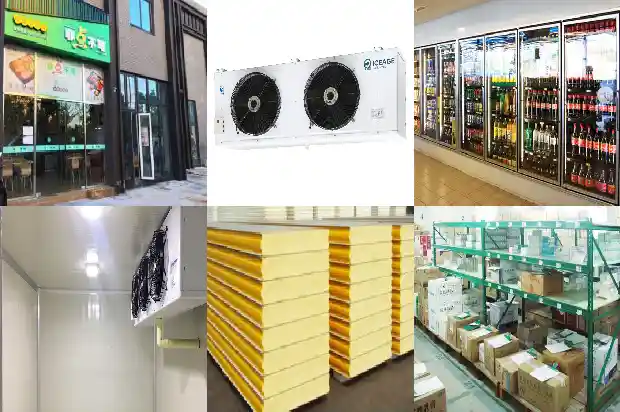Four Requirements for Refrigeration Systems Adopting Two - stage Compression Refrigeration Systems
2025-02-26
- Principle of Two - stage Compression Refrigeration Cycle
The two - stage compression refrigeration cycle divides the compression process into two stages. The low - pressure gas (with pressure ) from the evaporator is first compressed to an intermediate pressure () by the low - pressure - stage compressor. After being cooled by the intermediate cooler, it enters the high - pressure - stage compressor and is compressed to the condensing pressure () and then discharged into the condenser. The compression ratio of each of the two stages is maintained within 10.
For example, in a - 35/+35℃ system: the evaporation temperature is - 35℃, and the evaporation pressure (absolute pressure) is 0.093 Mpa; the condensing temperature is + 35℃, and the condensing pressure (absolute pressure) is 1.353 Mpa.
For a single - stage cycle: the compression ratio is .
For a two - stage cycle: the intermediate pressure is taken as 0.355 Mpa (absolute pressure); the compression ratio: for the high - pressure stage is ; for the low - pressure stage is .
The two - stage compression refrigeration cycle has different cycle forms due to different throttling stages and intermediate cooling methods. There are two - stage throttling and one - stage throttling, as well as complete intermediate cooling and incomplete intermediate cooling. The following introduces two commonly used two - stage compression cycles.
For a single - stage cycle: the compression ratio is .
For a two - stage cycle: the intermediate pressure is taken as 0.355 Mpa (absolute pressure); the compression ratio: for the high - pressure stage is ; for the low - pressure stage is .
The two - stage compression refrigeration cycle has different cycle forms due to different throttling stages and intermediate cooling methods. There are two - stage throttling and one - stage throttling, as well as complete intermediate cooling and incomplete intermediate cooling. The following introduces two commonly used two - stage compression cycles.
- One - stage Throttling and Complete Intermediate Cooling Two - stage Cycle
Usually, the two - stage compression ammonia refrigeration system adopts the complete intermediate cooling cycle. - Methods to Achieve Two - stage Compression
- A two - stage system composed of multiple compressors (two - stage combination), where one or several are used as the low - pressure stage and one is used as the high - pressure stage.
- A single - machine two - stage system composed of one compressor, such as a single - machine two - stage piston refrigeration compressor and a single - machine two - stage screw refrigeration compressor.
- Usually, the ratio of the volumetric displacement of the high - and low - pressure stages is 1:2 or 1:3.
And it is the most economical when .
- Characteristics of Adopting Two - stage Compression Refrigeration Cycle
Since the compression ratio of each stage is reduced, the volumetric efficiency of the compressor is greatly improved.
With intermediate cooling, the discharge temperature of the high - pressure stage is reduced, and the lubrication conditions of the compressor are improved.
Power consumption is reduced. For example, when and , the power consumption of using two - stage compression is 12% less than that of using single - stage compression.
Adopting two - stage compression requires one more compressor, one intermediate cooler, and one throttle valve than single - stage compression, increasing the investment cost. Therefore, it is only reasonable to adopt two - stage compression at low evaporation temperatures.
Related Articles
- What Vacuum Requirements Do Cold Storage Equipment Have?
- What Special Requirements are There for the Installation of Tea Cold Storage?
- Requirements and Maintenance for Building Meat Food Cold Storage
- Requirements of Cold Storage Insulation for Maintaining Stable Temperature Inside
- Temperature Requirements for Various Cold Storages
- Return Bend Setup and Installation Technical Requirements
- Types and Temperature Requirements of Seed Cold Storages
- Differences, Requirements and Standards between Pharmaceutical Cold Storage and Conventional Cold Storage
- Technical quality requirements for refrigerators after repair
- System Airtightness Experiment Requirements and Steps
- Screw Compressor Units: Principles, Design and Selection - Essential Guide for Refrigeration Beginners
- Don't Overlook: The Impact of Capillary Tube Length on Refrigeration System Parameters
- Refrigeration Repair Techniques: A Must - Know - "Sub - cooling" and "Super - heating"
- What Impact Does Pressure Have on the Refrigeration System?
- Advanced Guide! Design and Installation of Refrigeration System Pipelines
- Defrosting Heating Tubes in Refrigeration Devices
- Refrigeration Components of Refrigeration
- Refrigeration System: Copper Pipe Welding and Flushing Operations
